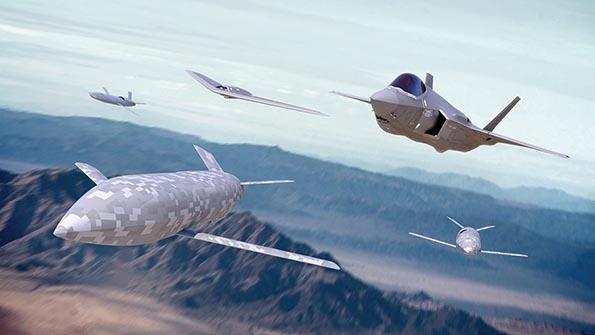
SPARKS, Nevada—The U.S. Air Force, Navy and Marine Corps have agreed to work together on developing collaborative combat aircraft (CCA) by standardizing multiple components of their respective systems, as the Navy is finalizing its requirements and acquisition strategy.
This year, the three services agreed to a common baseline for CCA command and control, communications, autonomy and mission system standards as a way to keep the programs progressing on schedule and interoperable, says Capt. Nick Saunders, the CCA requirements officer with the Navy’s Office of Naval Warfare N98.
The Navy has submitted a draft top-level requirements document and draft acquisition strategy to the service’s acquisition executive, Frederick Stefany, and a classified industry day is expected in the near future, according to an N98 briefing at the Tailhook Symposium here.
Saunders says the Navy wants a fighter-sized air vehicle with modular payloads that can be adjusted for individual missions for carrier air wings. The autonomous aircraft need longer range than the service’s crewed fighters, and increased loiter time.
The plan is for the initial CCAs to be fielded and operated by existing fourth- and fifth-generation fighters along with command-and-control aircraft, before eventually being controlled by sixth-generation F/A-XX fighters.
To get there, CCAs need to be provided on a fast schedule and at a low cost to deliver the capability to the fleet, Saunders says.
“We are going to compete the Navy collaborative combat aircraft program of record,” he says.
The trailblazer for much of the Navy’s autonomous plans is the Boeing MQ-25 Stingray uncrewed aircraft. The MQ-25 will take over the refueling mission handled by the F/A-18 along with providing intelligence, surveillance and reconnaissance. The MQ-25 is controlled by the Lockheed Martin MD-5 Ground Control Station, which is expected to oversee future carrier-based autonomous aircraft.
The Navy is installing Unmanned Air Warfare Centers (UAWC) with the ground control stations on four carriers. Addtionally, UAWCs for future Ford-class carriers are being designed.
The Navy also is joining the U.S. Air Force in working with the Royal Australian Air Force on Boeing Australia’s MQ-28 Ghost Bat. Since the MQ-28 is a “flying, functional” CCA, it can be used to help the Navy learn how to operate such aircraft and integrate into its plans, Saunders says. This year, the Navy, Air Force and RAAF agreed to establish a “program arrangement” to collaborate on MQ-28 so the American services can take advantage of Australia’s work.
